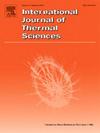不同截面形状超临界CO2蓄热式冷却通道流动与传热特性的数值研究
IF 4.9
2区 工程技术
Q1 ENGINEERING, MECHANICAL
International Journal of Thermal Sciences
Pub Date : 2025-04-30
DOI:10.1016/j.ijthermalsci.2025.109965
引用次数: 0
摘要
由于出色的传热传质能力,本研究采用超临界CO2作为煤油的补充冷却剂,在极高马赫数(Ma≥8)下进行再生冷却。研究了截面形状、流型和壁面材料对流动结构和传热性能的影响,并结合熵产分析进行了研究。结果表明,三角形通道的换热系数最高,而方形通道的摩擦系数最低。结合热力学第一定律和热力学第二定律,得出了三角形截面通道具有最佳热性能的结论。圆形截面的通道在通道出口处表现出更好的性能,这主要是由于其湍流动能更大,动量和热边界层更薄。相邻通道的相反流动方式不仅可以使壁面最高温度降低至少10%,而且可以提高壁面温度的均匀性,促进相邻通道之间的换热。与高温合金相比,采用Cu作为通道材料可使传热性能提高16.7%。本文章由计算机程序翻译,如有差异,请以英文原文为准。
Numerical investigations of flow and heat transfer characteristics of a regenerative cooling channel using supercritical CO2 with different cross-section shapes
Because of the excellent heat and mass transfer ability, this study employed supercritical CO2 as a supplementary coolant to kerosene for regenerative cooling at extremely high Mach numbers (Ma≥8). The study investigated the effects of cross-section shapes, flow patterns, and wall materials on the flow structures and heat transfer performance associated with entropy generation analysis. From the results, the triangular channel has highest heat transfer coefficient, while the square channel has the lowest the friction factor. Considering both he first and second law of thermodynamics, it is concluded that the channel with the triangular cross-section provides the best thermal performance. The channel with the circular cross-section shows better performance at the channel outlet, primarily attributed to its larger turbulent kinetic energy and thinner momentum and thermal boundary layers. The opposite flow pattern of adjacent channels can not only reduce the maximum wall temperature by at least 10 %, but also improve the wall temperature uniformity and promote heat transfer between adjacent channels. Compared with high-temperature alloys, using Cu as channel materials can greatly increase the heat transfer performance by 16.7 %.
求助全文
通过发布文献求助,成功后即可免费获取论文全文。
去求助
来源期刊

International Journal of Thermal Sciences
工程技术-工程:机械
CiteScore
8.10
自引率
11.10%
发文量
531
审稿时长
55 days
期刊介绍:
The International Journal of Thermal Sciences is a journal devoted to the publication of fundamental studies on the physics of transfer processes in general, with an emphasis on thermal aspects and also applied research on various processes, energy systems and the environment. Articles are published in English and French, and are subject to peer review.
The fundamental subjects considered within the scope of the journal are:
* Heat and relevant mass transfer at all scales (nano, micro and macro) and in all types of material (heterogeneous, composites, biological,...) and fluid flow
* Forced, natural or mixed convection in reactive or non-reactive media
* Single or multi–phase fluid flow with or without phase change
* Near–and far–field radiative heat transfer
* Combined modes of heat transfer in complex systems (for example, plasmas, biological, geological,...)
* Multiscale modelling
The applied research topics include:
* Heat exchangers, heat pipes, cooling processes
* Transport phenomena taking place in industrial processes (chemical, food and agricultural, metallurgical, space and aeronautical, automobile industries)
* Nano–and micro–technology for energy, space, biosystems and devices
* Heat transport analysis in advanced systems
* Impact of energy–related processes on environment, and emerging energy systems
The study of thermophysical properties of materials and fluids, thermal measurement techniques, inverse methods, and the developments of experimental methods are within the scope of the International Journal of Thermal Sciences which also covers the modelling, and numerical methods applied to thermal transfer.
 求助内容:
求助内容: 应助结果提醒方式:
应助结果提醒方式:


